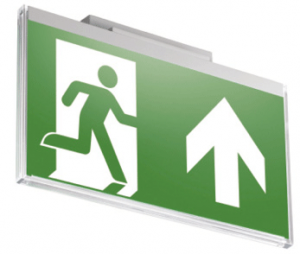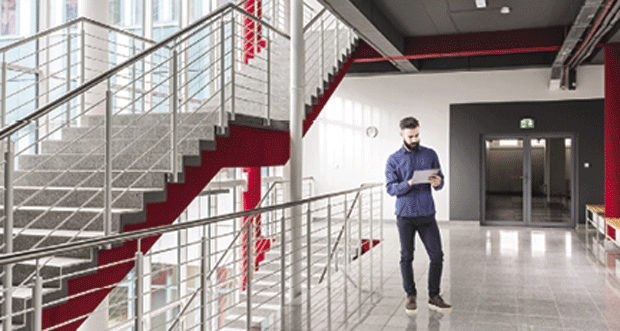 Thorsten Mueller, Head of Global Product Group Building and Home Automation Solutions at ABB explains why the digitalisation of emergency lighting is vital
Thorsten Mueller, Head of Global Product Group Building and Home Automation Solutions at ABB explains why the digitalisation of emergency lighting is vital
In the current climate, facilities managers are facing constant changes to how buildings are used and occupied, particularly in the commercial office, hospitality, retail and public sectors – and critical sectors such as data centres and healthcare. This is why making sure emergency lighting is effective has never been more important.
Having remote, digital control of emergency lighting can not only save time and up to 30 per cent on running costs but it can also provide real-time performance data to help ensure regulatory obligations are met and safety is maintained.
With emergency lighting being a mandatory requirement in any industrial, commercial or public sector building that uses artificial lighting, ensuring it is both managed effectively and regularly monitored and tested are major obligations for facilities or buildings managers, particularly where they are managing multiple sites.
As a result, having clear and direct visibility of robust data on the performance and maintenance of emergency lighting is critical and this is where digitalisation comes into its own.
TESTING, TESTING
Owners, facilities or building managers are legally responsible and accountable for their emergency lighting installation. Both legislation and standardisation require emergency lighting to be tested in accordance with local standards, which provide an explanation of inspection, maintenance and logbook records.
All emergency lighting installations require, just like other building and home automation solutions such as fire alarms or heating ventilation and air conditioning (HVAC) systems – regular maintenance. This applies to maintained or non-maintained emergency lighting, whether it is lit continuously or not.
In practice, ongoing inspection, maintenance and testing of emergency lighting is a time-consuming process that must be carried out regularly during every year that the installation is in place.
However, these costs can be mitigated with a smart centralised digital system, which can be managed remotely via an app.
SAVING TIME AND MONEY
Inspecting emergency lighting luminaires can be a major task. Luminaires need to be inspected on site, piece by piece, to check that the PCB, light source and battery are working. With the advent of digitalisation, this can now be done much more effectively with an app-based monitoring system, which offers users multiple benefits.
Using a smart system allows facilities managers to concentrate on what matters – letting the emergency lighting luminaire system manage itself and reduce the amount of time monitoring it.
Testing, inspection and maintenance planning can also be scheduled to ensure all emergency luminaires are working properly. In addition, functional and duration tests can easily be programed, and faults automatically detected and reported directly to a mobile device providing anytime, anyplace, anywhere notification.
Multiple users can also access the data held on the emergency lighting system, which can be emailed, shared and stored to provide a permanent record of the health of the system.
This will save a considerable amount of money on maintenance time, enabling users to focus on resolving problems as and when they happen, leading to up to 30 per cent savings on annual costs.
A digital solution gives managers 24/7 control of building safety systems and improves the ability of occupants to respond to emergencies and maintain health and safety.
 To further enhance building safety, a smart system can send maintenance alerts in the app, allowing faulty components to be replaced before a malfunction occurs.
To further enhance building safety, a smart system can send maintenance alerts in the app, allowing faulty components to be replaced before a malfunction occurs.
All of this is designed to optimise the safety of visitors and building users. As a result, there is no need for unnecessary equipment handling, complicated paperwork, or travel for replacement parts. Documents can also be used to evidence the safety of the system to building or insurance companies and serve as a permanent cloud-based record of maintenance and testing.
USING THE CLOUD FOR PEACE OF MIND
For FMs that are responsible for managing single or multiple sites – potentially across several geographical locations – a smart emergency lighting system allows them to monitor any building installation from anywhere in the world, at any time, so that resources can be concentrated where they are needed most.
Through the use of an app, self-contained emergency luminaires can be easily installed and programmed into a building in a fast and intuitive way. The system also provides a digital overview via the cloud, giving instant information to assist resource planning and enhance building safety, which can be managed from any smart handheld device.
This allows users to control their emergency lighting system, while keeping a record of all activity safely in the cloud, giving complete peace of mind on the safety of the installation and allowing the potential for connected emergency lighting solutions in the future.
From a geographical perspective, the fact that all emergency luminaire data is stored in the cloud allows for a 24/7 overview of all smart monitored buildings via Google maps. To give real-time status and provide a clear and precise location of the emergency lighting luminaire, building maps can be uploaded and overlaid onto Google maps. Users can also upload floorplans directly into the app, so that they can view all emergency luminaires on the floor or select one luminaire and locate its precise location in the building.
CONCLUSION
Effective emergency lighting is key to ensure that buildings comply with standards and Government regulations. It is also essential to ensure the safety of its occupants.
Harnessing the power of digitalisation gives building owners and facilities managers total control over their luminaires, to not only reduce operating and maintenance costs by up to 30 per cent, but, more importantly, to make sure that buildings are as safe as they can be.
With digital solutions now providing anytime anywhere visibility on how their emergency lighting is performing, we have the tools to not only reduce the administrative and time burden of meeting regulatory obligations, but to operate remotely and quickly respond to any issues.
This connected approach, providing a 24-hour view of the building from anywhere in the world, puts control firmly back in the hands of the operator, driving both cost and energy savings and putting safety firmly at the top of the agenda.





